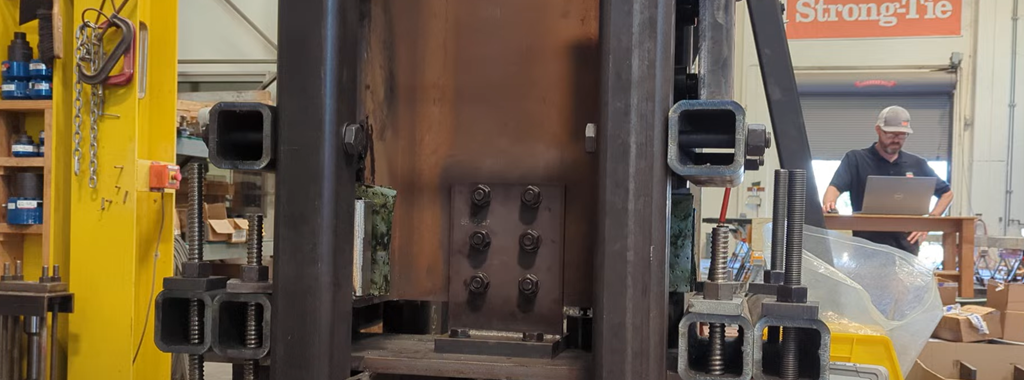Moment connections are a common lateral system in structural steel design, offering the advantage of unobstructed sight lines and clear passageways. However, they often come with significant cost and labor demands. Fully welded moment connections require extensive beam preparation, welding, and inspection, while common bolted solutions, such as flange-plated and end-plate moment connections, still involve welded components, leading to installation and fit-up challenges.
Flange-plated connections use plates with predrilled bolt holes shop-welded to the column. Providing the correct plate spacing while accounting for field tolerances and variations in beam depth can be challenging.

End-plate moment connections have predrilled plates welded to the end of the beam instead. Ensuring the beam end is cut square, preventing plate warping during welding, and accounting for variations in column depth are all critical for fit-up.

Tee-stub connections, which predate end-plate moment connections, offer the best of both worlds as both the column and beam side of the connection are bolted. However, they are uncommon in modern steel construction. Fabrication shops are not optimized to produce these relatively small, complex components, whose quality can significantly impact constructability. Detailing conventional double-tees can also be tricky as the connection may interfere with the space required for shear tab connections.

The new Strong-Link™ moment connection (SLMC) is an evolution of the double-tee, designed to address these challenges. It features a notched link flange, which allows larger connections to be installed on shallow beams while leaving adequate space for shear tab connections. These larger connections improve strength, stiffness, and ease of installation beyond what was previously possible. The improved geometry accommodates oversized holes at the column bolts, providing greater tolerance for variations in beam height and accelerating fit-up in the field. The SLMC is factory manufactured to Simpson’s high quality standards, reducing the labor and cost for the fabricator.

Physical Testing and Stiffness Validation
Structural steel moment connections can be categorized as partially restrained (PR) or fully restrained (FR) connections based on their stiffness behavior. This distinction has an impact on the design methodology for the structure because the moment-rotation characteristics of PR connections must be included in the analysis model. For low-seismic regions where delegated design is often used, FR connections avoid reanalysis of the structure and streamline the design process.
The AISC Specification establishes a stiffness requirement for classifying a moment connection as fully restrained. This requirement is based on ensuring the connection is stiff enough to develop 90% of the fixed-end moment associated with a fully rigid connection. The secant stiffness of the moment-rotation curve at service loads must exceed 20EI/L, where I is the moment of inertia and L is the theoretical length of the connected beam.
To verify the SLMC’s performance, physical testing was conducted to directly assess the stiffness behavior of individual SLMC components under both compression and tension loading. The results were translated into moment-rotation relationships to determine which SLMC sizes meet the FR classification criteria for various beam sizes and lengths.

Streamlining Design with a Comprehensive Guide
To simplify the design process, we’ve developed the SLMC design guide with useful aids for selecting and designing SLMC connections. This resource allows engineers to quickly determine available connection strengths and verify FR compliance. A detailed design example is also provided for reference.
With its improved strength, installation flexibility, and compliance with FR classification, the SLMC provides a field-friendly, cost-effective solution for moment connections in low-seismic and wind-governed regions.
Want to learn more? Watch the recording of our in-depth webinar on the Strong-Link™ moment connection.




